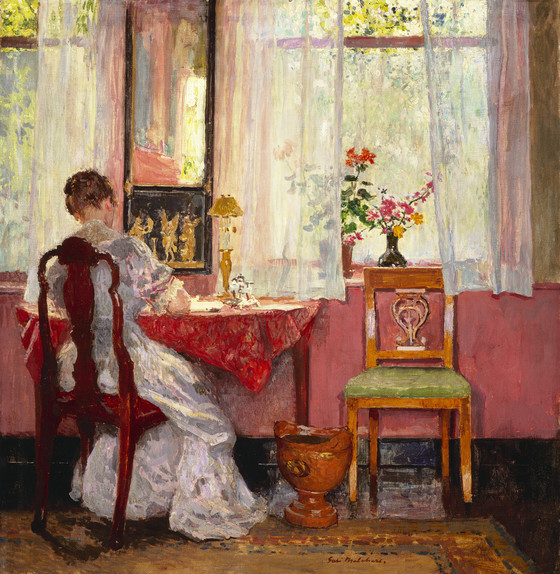After his marriage to Corinne Lawton Mackall in 1903, Gari Melchers began painting interior genre scenes, which may reflect his new-found domestic bliss and increased financial security....
After his marriage to Corinne Lawton Mackall in 1903, Gari Melchers began painting interior genre scenes, which may reflect his new-found domestic bliss and increased financial security. Unlike his earlier work, these scenes are filled with light and brilliant color and convey a certain bourgeois materialism. Their themes relate to the domestic interiors of Jan Vermeer (1632-1675), an artist who inspired Europeans, such as the Nabis, and Americans, such as Frank Benson (1862-1951) and EDMUND TARBELL, to paint images of middle-class women; they also parallel the "window series" CHILDE HASSAM was creating at about the same time. Mrs. Gari Melchers usually served as her husband’s model and often was shown occupied in some commonplace activity, frequently accompanied by a servant. In Writing, as in most of Melchers’s genre paintings from 1905 to 1909, the scene is set in Schuylenburg, the former home of GEORGE HITCHCOCK near the Egmonds, in Holland.
Melchers’s interiors are usually bathed in sunlight. In Writing the sheer curtains of the double windows act as a filter, diffusing the strong light. Melchers painted his interiors with a full brush and pure color, demonstrating his new alliance with impressionism. In Writing Melchers used a brilliant palette of warm reds, pinks, and oranges, with passages of complementary colors -- the vibrant kelly green chair seat and pale blue curtains -- used as accents intensifying the effect of the major colors. The same shade of green appears in other of his interiors of the period, most notably The Green Lamp, 1905-9 (private collection). Writing is quieter than many of Melchers’s other interiors, without the floral wallpaper and lively patterned garments usually depicted.
More...
